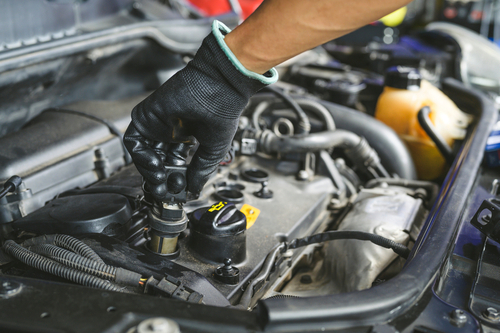Answer:
- 5/8″ (15.88mm): The most widely used size for spark plugs in many domestic cars and lawn equipment.
- 13/16″ (20.64mm): Another standard size primarily found in older or larger engines, such as those found in trucks.
- 3/4″ (19.05mm): Less frequently used but necessary for certain spark plug types and vehicles.
Spark Plug Socket Basics
When you’re working with spark plugs, the right tools can make all the difference. A spark plug socket is a specialized tool designed to fit snugly around the spark plug, allowing you to remove or install it without causing damage.
It typically has a rubber insert or a strong magnet to hold the plug in place.
Here’s what you need to know about spark plug sockets:
- Sizes: Spark plug sockets come in different sizes. The most common ones you’ll encounter are 5/8 inches (16mm), 3/4 inches (19mm), and 13/16 inches (20.6mm).
- Types: Besides standard sizes, some spark plugs may require slim or swivel sockets due to tight spaces.
- Drive Size: Usually, spark plug sockets come with a 3/8-inch or 1/2-inch drive to match your ratchet.
- Construction: They are often made from chrome-plated steel for durability.
- Identification: Many have size markings stamped on them to help you easily identify the size you need.
When selecting a socket:
- Match your socket size to the spark plug.
- Opt for one with a rubber insert if you’re worried about the plug slipping.
- Choose a magnetic socket for a better hold if necessary.
- Ensure your ratchet drive size corresponds with the drive size of the socket.
- Remember to attach your extension bar securely if you’re navigating deep wells or narrow spaces.
Spark Plug Socket Sizes

Spark plug sockets come in various sizes to fit the spark plugs of different engines, and using the correct size ensures that you can remove or tighten a spark plug without damaging it.
Metric Sizes
- 14mm: Commonly used for most modern engines, especially on motorcycles and many Japanese cars.
- 16mm: Less common, but used for some applications; worth having in your toolbox.
- 18mm: Often found in larger engines and some older models; can be more prevalent in specialized equipment.
Standard SAE Sizes
- 5/8″ (15.88mm): The most widely used size for spark plugs in many domestic cars and lawn equipment.
- 13/16″ (20.64mm): Another standard size primarily found in older or larger engines, such as those found in trucks.
- 3/4″ (19.05mm): Less frequently used but necessary for certain spark plug types and vehicles.
Specialty Sockets
- Magnetic Sockets: These hold onto the spark plug more securely, reducing the chance of dropping the plug during installation or removal.
- Swivel Sockets: Offer a pivoting joint for easier access to spark plugs in tight or awkward spaces.
- Extra Long Sockets: Designed to reach spark plugs that are deep within the engine block.
Selecting the Right Socket

Choosing the appropriate socket size for your spark plug is a practical step in performing routine vehicle maintenance.
Vehicle Manufacturer Specifications
- Check your vehicle’s owner manual for the recommended socket size.
- Manufacturers often specify the exact size that fits your car’s spark plugs.
Spark Plug Types and Compatibility
- Spark plugs come in various thread diameters and hex sizes.
- Typical thread diameters include 10mm, 12mm, 14mm, and 18mm.
- Common hex sizes are 5/8″ (16mm), 3/4″ (19mm), and 13/16″ (20.6mm).
Use a dedicated spark plug socket with a rubber insert to prevent damage to the plug’s ceramic body.
Plugs are Tough to Get To: Here’s Some Tips
When selecting a socket wrench for spark plugs, size precision is crucial. Spark plugs require a specific drive size:
- Common Sizes: Typically, you’ll use a 3/8-inch drive for most spark plugs.
- Deep Socket: Spark plug sockets are deeper to accommodate the length of the spark plug.
Compatibility with your spark plug’s hex size is vital:
- Standard Sizes: Usually, spark plug sockets come in two sizes, 5/8 inches and 13/16 inches.
- Metric Alternatives: For certain vehicles, you might require a 14mm, 16mm, or 18mm socket.
The build quality matters:
- Material: Durable, corrosion-resistant alloys are preferable.
- Insulation: A rubber gasket inside the socket helps to protect the plug’s ceramic body.
Additionally, consider the following features:
- Swivel Head: Offers better maneuverability in tight spaces.
- Extension Bars: To reach spark plugs located deep in the engine bay.
- Magnetic or Rubber Retaining Rings: Helps in maintaining grip on the spark plug during removal or installation.
Consider your ratchet’s handle:
- Length: A longer handle provides more leverage but needs more clearance.
- Grip: Ensure a comfortable and non-slip grip for safety and efficiency.
- Regularly clean your socket with a degreaser to prevent dirt build-up.
- Inspect your tools for wear. A worn socket can lead to poor grip and slippage.
- Keep sockets in a dry environment to avoid corrosion.
- Use a socket organizer to prevent loss and ease socket selection.
- Always align your socket correctly to apply force evenly.
- Avoid using extension bars as they can lead to over-torquing.
- Use a torque wrench according to the manufacturer’s specifications.
- Recheck the torque setting before each use.




